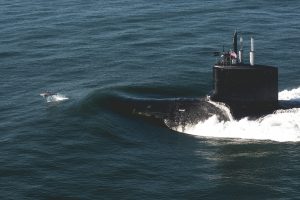In a shock move, Australia announced that it will abandon its AUS$90 billion program to buy conventionally-powered submarines from France to replace its aging Collins–class boats. Instead, in conjunction with the United States and United Kingdom, Canberra will develop nuclear-powered submarines as the first part of a deepened trilateral defense agreement announced in a joint video call between Prime Ministers Scott Morrison and Boris Johnson and President Joe Biden.
It should be noted first of all that the details of this arrangement are still very much to be determined. But the fact that Australia is choosing to nuclearize its submarine fleet – and the fact that the U.S. and U.K. are actively involved in that effort – is a major development both technologically and strategically.
Sixty-six years after the USS Nautilus became the first submarine to set sail using the power of the atom, nuclear-powered submarines remain an even rarer commodity than nuclear weapons. The five original nuclear weapons states – China, France, Russia, the U.K., and the U.S. – all operate nuclear submarines (including those designed to carry nuclear-tipped ballistic missiles). But despite various abortive efforts in years past, only India has successfully joined that set (and at that, with only one leased Russian submarine and one domestically constructed one). Brazil is constructing a nuclear-powered submarine – again, with French assistance – though it is likely years away from entering into service.
It is not clear yet whether Australia will buy an off-the-shelf design from the U.S. or U.K. (of which there are only two real contenders: the American Virginia class or the British Astute class), or develop a class of its own, in partnership with American and British shipbuilders. The former option would be simpler, though it would likely require a potentially divisive competition between the Americans and British; the latter might well add years to what is already a lengthy and complex process. In either case, Morrison’s government intends for the new boats to be built in Adelaide.
In any case, the new arrangement is a significant change from the previous Australian plan to procure conventionally-powered variants of a French nuclear attack sub design. Conventional submarines – generally powered by a combination of diesel engines and battery-powered electric motors, though newer designs use hydrogen fuel cells – do have some advantages over nuclear boats. They tend to be cheaper and less complicated (though as the immense cost of the now-abandoned French/Australian deal shows, hardly cheap or simple). The machinery is smaller, allowing for more compact designs capable of hiding in shallow waters and complex undersea geographies, where larger nuclear subs might be more constrained. And as naval exercises over the years have shown, conventional submarines can be deadly predators, fully capable of sneaking up on a carrier battle group and placing its flagship squarely in their crosshairs.
But there is a reason why the French, British, and American navies have moved to an all-nuclear submarine fleet. Nuclear propulsion gives submarines effectively unlimited range and the ability to operate underwater without ever coming to the surface to recharge batteries – providing significant tactical and strategic advantages, especially for an island country with huge expanses of ocean on all sides like Australia. Nuclear propulsion allows for bigger, more flexible designs: a modern nuclear-powered attack submarine can simultaneously carry torpedoes, land-attack cruise missiles, special forces personnel, and even UAVs, allowing it to undertake numerous types of missions on demand without needing to return to base and reconfigure first.
None of this comes cheaply. Developing the underlying infrastructure to safely generate nuclear fuel; design, build, maintain, and refuel the boats; and safely dispose of spent fuel and – eventually – the submarines themselves will take decades and cost billions. Steer Google Maps’ satellite view to Rosyth Dockyard in Fife or Bremerton, Washington and you will find the hulls of previous generations of British and American nuclear submarines going through the costly, years-long process of dismantlement, a cost not borne by operators of conventional submarines. And while the direct risks associated with nuclear propulsion are less acute than those associated with nuclear weapons, they are real and should not be ignored.
The driving factor behind all of this, of course, is China, whose navy is growing far more rapidly than that of the United States, even if some of its high-end capabilities are still immature or unproven. Developing a long-range, high-endurance fleet of Australian submarines – and looping in the U.K., which has a stated strategic interest in the Indo-Pacific region but no permanent presence there – makes sense as a way to begin to address that imbalance. However, the French government’s anger at not only losing the contract but also being left out of the new defense pact will need to be managed by Canberra, London, and Washington – unless the theory is that the threat posed by Beijing is so great that Paris will have no choice but to swallow its pride and cooperate anyway.
In times of war, submarines are a critical national asset, even a war-winning one. Outside of active hostilities, though, submarines are an odd way to declare national intent. They rely on silence and invisibility to maintain their strategic impact; they derive their strength from their ambiguity and lose it if spotted. That distinction, perhaps, explains why an often-overlooked weapon is making so many headlines right now.

































